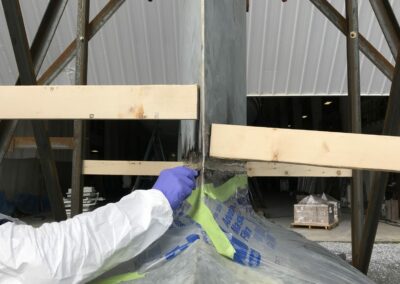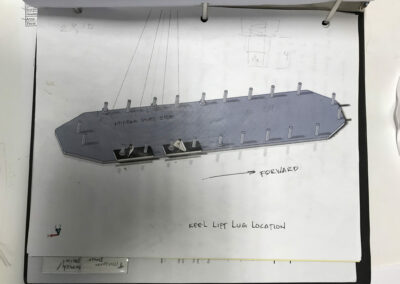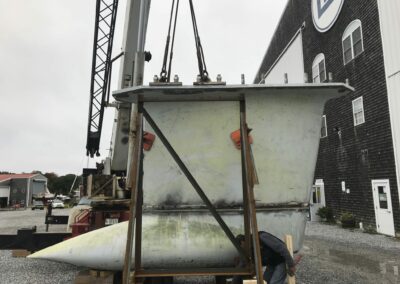33-Ton Ballast Keel Removal, Inspection, and Reinstallation
Lyman-Morse Boatbuilding

All photos courtesy Lyman-Morse Boatbuilding. Above photo: The Swan 100’s 33-ton keel will be removed from the nearly 80-ton yacht so it can be fully inspected and re-installed.
Lyman-Morse Boatbuilding Company, a Certified Swan Service Center in Thomaston, Maine, has been performing refits on Nautor’s Swan 100s in its 22,000-square-foot service building. The Swan 100 is a German Frers design with an overall length of just over 99 feet, a beam of 23.2 feet, and a draft of 13.2 feet. One of the projects, on a Swan 100 built in 2006, required removing the 33-ton keel for inspection of the keel, bulb, and keel bolts. While the keel was off, Lyman-Morse’s team removed the keel bulb and extended the keel ¾” to accommodate an equipment weight-reduction aboard, as explained below.
Preparing for the Keel Removal
Lyman-Morse (LM) Project Manager Lance Buchanan and his crew spent about two weeks removing the engine, generator, battery banks, and most of the cabin sole in the Swan 100’s main salon in order to access the 22 keel bolts, of 52 mm (just over two-inch) diameter AISI 329 stainless steel. These threaded fittings extend about 6 inches above the top of the keel flange. They are engineered to just pass through the bottom of the hull enough to be secured by the massive four-inch-wide, 316 stainless steel nuts.
Before the keel can be removed, the LM team designs, and LM Fabrication constructs a metal cradle to support the keel and ballast bulb to ensure that it will remain oriented precisely and securely vertical when the hull is lifted from the keel.
To begin the removal process, the Travelift hauls the Swan 100 outside to set the keel on the waiting cradle, where an LM mechanic, armed with a powerful torque-multiplying wrench, then exerts the 1600 foot-pounds of torque necessary to break each nut free.
To remove the keel, or more precisely, to remove the hull from the keel, Buchanan’s team carefully imparts a back-and-forth motion on the boat by carefully maneuvering the Travelift. First, the team slowly lifts the bow of the boat just a few inches. The idea is to get a sliver of daylight to peek in from between the bottom of the keel and the support cradle. That tiny distance is all that gravity needs to draw down the forward end of the keel, gently stressing the attachment points between keel and hull.
Once that full force on the keel fittings is felt by the vessel, the bow is gently lowered, and the forward portion of the keel is re-set back into the cradle.
The process is then repeated at the stern of the boat, and, inch-by-inch, the hull is literally “rocked” off the keel bolts until the keel separates from the hull, and sits perfectly and securely vertical in the support cradle.
Keel Inspection & Repair
With the keel removed from the hull, the LM crew begins inspecting the keel, keel bolts, and bulb for signs of corrosion and damage. Since the bolts in the keel flange are welded from the outside, Buchanan and his team opt to leave them in place rather than destroying the flange by removing them. Each bolt is dye-tested with penetrant dyes that soak into and reveal any cracks, corrosion, or damage. This testing revealed no such damage in the Swan 100.
Secure on blocking and jackstands, the condition of the recess for the keel flange can be thoroughly assessed.
Bulb Removal
Next, the LM team removed the 3-foot bolts that affix the bulb to the keel by removing the securing nuts on the underside of the bulb. The keel bolts themselves are then withdrawn from the threaded sockets inside the keel itself. These bolts are similarly dye-tested, revealing no corrosion or damage. They are then simply cleaned and prepared for reinstallation.
Bulb Inspection & Repair
This Swan 100 competes under the IRC, the ORC Superyacht, and the Caribbean Sailing Association (CSA) rules. During the refit at Lyman-Morse, she was outfitted with lighter lithium-ion batteries, which saved about two tons. Reducing the weight of the yacht would change its displacement and thus reduce righting moment, so the captain wanted to recapture that stiffness and power.
Since the bulb had to be removed from the keel for inspection, the captain calculated that he had enough length and thread on the keel bolts to replace the thin FRP “gasket” that compensated for irregularities between the bulb and the keel with a thicker one. So, a ¾” sheet of G10 laminate was fabricated to fit between the bulb and keel. Increasing the boat’s draft by this amount is expected to preserve windward performance while also providing some stability gains while reaching.
Keel Reinstallation
Finally, Buchanan and his team re-attached the reassembled keel to the hull, reversing the process by which it was removed – minus the rocking back-and-forth. After applying a layer of epoxy across the top of the keel, the hull is lowered onto the array of bolts by carefully maneuvering the Travelift. The keel bolt washers are bedded in 3M 4200 adhesive sealant, and a technician sets and re-torques the keel bolt nuts inside the hull.
The project comes to a conclusion as the LM team glasses over both the bulb-keel joint and the keel-hull joint with e-glass, fairing them in with Awlgrip’s Awlfair epoxy filler prior to application of the antifouling paint system.
At the captain’s request, LM replaced the thin FRP gasket with a ¾” G10 plate that they cut and bored to fit.
Bedding above and below the G10 plate with epoxy assures a watertight seal across all the bearing surfaces.
Schematic drawing of the top of the keel showing the placement of the moveable lifting lugs when the bulb is attached.
The Travelift moves the hull out of the service building and carefully positions it over the clamped keel assembly.
With epoxy generously applied to the top of the keel flange, the hull is carefully lowered into place upon the keel.
The keel flange is fitted securely into the recess, the keel bolt nuts are torqued down inside, and the yacht is moved back into the service building for finishing work.
Further Reading
Lyman Morse: www.lymanmorse.com
Nautor’s Swan: https://usa.nautorswan.com/en/home/
Frers Design: http://germanfrers.net/about/





















Is there anything done to the epoxy joints between the bulb and keel and keel and hull to allow removal in the future?
Thanks, Michael. A reply will be coming your way.
That’s a good question, Michael, and was a major discussion prior to reassembly. We ended up priming the top of the keel with AwlGrip 545 Epoxy Primer. The epoxy-to-primer bond line should be the separation point if the keel ever needs to be removed again, but it will certainly be hard to break free.
First time looking your site great job well done.
Thanks, Roy. We’re just getting started, and we appreciate it!
Yes, I wondered the same thing. Why was epoxy chosen between the pieces instead of a sealant like 3M 4200 adhesive sealant used to seal the bolts? It appears from the article that there wasn’t anything used when the vessel was originally built.